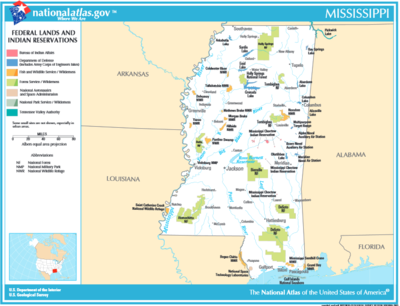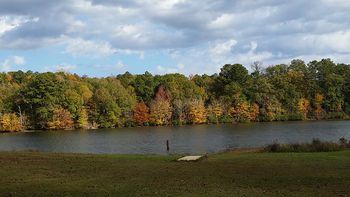It’s the 12 Days of Ballotpedia! Your gift powers the trusted, unbiased information voters need heading into 2026. Donate now!
Federal land policy in Mississippi
![]() This article does not contain the most recently published data on this subject. If you would like to help our coverage grow, consider donating to Ballotpedia.
This article does not contain the most recently published data on this subject. If you would like to help our coverage grow, consider donating to Ballotpedia.
| Public Policy |
|---|
 |
| State environmental policy |
Federal land policy involves the ownership and management of land owned by the federal government. As of 2012, the federal government owned between 635 million to 640 million acres, or 28 percent, of the 2.27 billion acres of land in the United States. Federal land is managed for many purposes, such as the conservation and development of natural resources, grazing and recreation. As of 2012, the federal government owned 5.04 percent of Mississippi's total land, 1,523,573 acres out of 30,222,720 total acres.
Land ownership
- See also: Federal land policy and Federal land ownership by state
The federal government owned between 635 million and 640 million acres of land in 2012 (about 28 percent) of the 2.27 billion acres of land in the United States. Around 52 percent of federally owned acres were in 12 Western states—including Alaska, 61 percent of which was federally owned. In contrast, the federal government owned 4 percent of land in the other 38 states. Federal land policy is designed to manage minerals, oil and gas resources, timber, wildlife and fish, and other natural resources found on federal land. Land management policies are highly debated for their economic, environmental and social impacts. Additionally, the size of the federal estate and the acquisition of more federal land are major issues.[1][2]
According to the Congressional Research Service, Mississippi spans 30.22 million acres. Of that total, 5.04 percent, or 1.52 million acres, belonged to the federal government as of 2012. More than 28 million acres in Mississippi are not owned by the federal government, or 9.59 non-federal acres per capita. From 1990 to 2010, the federal government's land ownership in Mississippi increased by 45,047 acres.[1]
The table shows federal land ownership in Mississippi compared to its neighbor, Alabama, and a Western state, Wyoming. The U.S. Forest Service owned more than 1.1 million acres in Mississippi compared to 670,185 acres in Alabama and more than 9.2 million acres in Wyoming. The U.S. Fish and Wildlife Service, which manages endangered species, owned 211,164 acres in Mississippi, which was more than in Alabama and Wyoming.
| Federal land ownership in Mississippi and other states by agency | |||||||||||
|---|---|---|---|---|---|---|---|---|---|---|---|
| State | |||||||||||
| Agency | Mississippi | Alabama | Wyoming | ||||||||
| Acres owned | Percentage owned | Acres owned | Percentage owned | Acres owned | Percentage owned | ||||||
| U.S. Forest Service | 1,173,898 | 77.05% | 670,185 | 76.92% | 9,241,610 | 30.76% | |||||
| U.S. National Park Service | 104,004 | 6.83% | 16,714 | 1.92% | 2,344,852 | 7.80% | |||||
| U.S. Fish and Wildlife Service | 211,164 | 13.86% | 32,207 | 3.70% | 70,674 | 0.24% | |||||
| U.S. Bureau of Land Management | 241 | 0.02% | 3,523 | 0.40% | 18,370,351 | 61.15% | |||||
| U.S. Department of Defense | 34,266 | 2.25% | 148,603 | 17.06% | 16,025 | 0.05% | |||||
| Total federal land | 1,523,573 | 100% | 871,232 | 100% | 30,043,512 | 100.00% | |||||
| Source: Congressional Research Service, "Federal Land Ownership: Overview and Data" | |||||||||||
Land usage
Recreation
National parks in Mississippi
Mississippi has eight National Park Service units, one national forest and three wilderness areas. A study by the U.S. National Park Service found that 6.78 million visitors attended Mississippi's national parks and monuments and generated $202.9 million in visitor spending in 2013.[3]
State recreation lands
The table below contains a list of all state parks in Mississippi.[4]
| State parks in Mississippi | ||||||
|---|---|---|---|---|---|---|
| State park name | ||||||
| J.P. Coleman State Park | ||||||
| Wall Doxey State Park | ||||||
| Tishomingo State Park | ||||||
| John W. Kyle State Park | ||||||
| Trace State Park | ||||||
| George P. Cossar State Park | ||||||
| Tombigbee State Park | ||||||
| Great River Road State Park | ||||||
| Hugh White State Park | ||||||
| Florewood State Park | ||||||
| Lake Lowndes State Park | ||||||
| Legion State Park | ||||||
| Holmes County State Park | ||||||
| Leroy Percy State Park | ||||||
| Golden Memorial State Park | ||||||
| LaFleur's Bluff State Park | ||||||
| Roosevelt State Park | ||||||
| Clarkco State Park | ||||||
| Natchez State Park | ||||||
| Lake Lincoln State Park | ||||||
| Percy Quin State Park | ||||||
| Paul B. Johnson State Park | ||||||
| Buccaneer State Park | ||||||
| Shephard State Park | ||||||
Economic activity on federal lands
Oil and gas activity
- See also: BLM oil and gas leases by state
Private mining companies, including oil and natural gas companies, can apply for leases from the U.S. Bureau of Land Management (BLM) to explore and produce energy on federal land. The company seeking a lease must nominate the land for oil and gas exploration to the BLM, which evaluates and approves the lease. The BLM state offices make leasing decisions based on their land use plans, which contain information on the land's resources and the potential environmental impact of oil or gas exploration. If federal lands are approved for leasing, the BLM requires an application from the company containing information on how the exploration, drilling and production will be conducted. Afterward, the BLM will produce an environmental analysis and a list of requirements before work on the land can begin. The agency also inspects the companies' drilling and producing on the leased lands.[5]
In 2013, there were 47,427 active leases covering 36.09 million acres of federal land nationwide. Of that total, 849 leases (1.79 percent of all leases), covering 475,639 acres (1.32 percent of all leased land in 2013), were in Mississippi. In 2013, out of 3,770 new drilling leases approved nationwide by the BLM for oil and gas exploration, 6 leases (0.001 percent) were in Mississippi.[6][7][8][9][10]
The table below shows how Mississippi compared to neighboring states in oil and gas permits on BLM-managed lands in 2013. Mississippi had the most active leases compared to neighboring states. Mississippi had more acres under leases than Albama and Louisiana but fewer than Arkansas.
| Oil and gas leasing on BLM lands by state | ||||
|---|---|---|---|---|
| State | Active permits on BLM lands (FY 2013) | Total acres under lease (FY 2013) | State percentage of total permits | State percentage of total acres |
| Mississippi | 849 | 475,639 | 1.79% | 1.32% |
| Alabama | 138 | 75,390 | 0.29% | 0.21% |
| Arkansas | 742 | 490,363 | 1.56% | 1.36% |
| Louisiana | 525 | 297,028 | 1.11% | 0.82% |
| Total United States | 47,427 permits | 36,092,482 acres | - | - |
| Source: U.S. Bureau of Land Management, "Oil and Gas Statistics" | ||||
Payments in lieu of taxes
- See also: Payments in lieu of taxes
Since local governments cannot collect taxes on federally owned property, the U.S. Department of the Interior issues payments to local governments to replace lost property tax revenue from federal land. The payments, known as "Payments in Lieu of Taxes" (PILTs), are typically used for funding services such as fire departments, police protection, school construction and roads.[11]
The table below shows PILTs for Mississippi compared to neighboring states between 2011 and 2013. Mississippi received more PILTs in 2013 than Alabama and Louisiana but fewer than Arkansas.
| Total PILTs for Mississippi and neighboring states | ||||||
|---|---|---|---|---|---|---|
| State | FY 2011 | FY 2012 | FY 2013 | State's percentage of 2013 total | ||
| Mississippi | $1,560,083 | $1,611,979 | $1,580,410 | 0.39% | ||
| Alabama | $721,010 | $805,176 | $901,119 | 0.22% | ||
| Arkansas | $4,923,263 | $5,277,001 | $5,840,895 | 1.45% | ||
| Louisiana | $554,343 | $609,979 | $634,317 | 0.16% | ||
| Source: U.S. Department of the Interior, "PILT" | ||||||
Environmental policy in the 50 states
Click on a state below to read more about that state's energy policy.
See also
External links
Footnotes
- ↑ 1.0 1.1 Congressional Research Service, "Federal Land Ownership: Overview and Data," accessed September 15, 2014
- ↑ U.S. Congressional Research Service, "Federal Lands and Natural Resources: Overview and Selected Issues for the 113th Congress," December 8, 2014
- ↑ U.S. National Park Service, "2013 National Park Visitor Spending Effects Report," accessed October 14, 2014
- ↑ Mississippi Department of Wildlife, Fisheries and Parks, "State Parks," accessed December 16, 2014
- ↑ U.S. Bureau of Land Management, "Oil and Gas Lease Sales," accessed October 20, 2014
- ↑ U.S. Bureau of Land Management, "Number of Acres Leased During the Fiscal Year," accessed October 20, 2014
- ↑ U.S. Bureau of Land Management, "Total Number of Leases in Effect," accessed October 20, 2014
- ↑ U.S. Bureau of Land Management, "Summary of Onshore Oil and Gas Statistics," accessed October 20, 2014
- ↑ U.S. Bureau of Land Management, "Number of Drilling Permits Approved by Fiscal Year on Federal Lands," accessed October 20, 2014
- ↑ U.S. Bureau of Land Management, "Total Number of Acres Under Lease As of the Last Day of the Fiscal Year," accessed October 22, 2014
- ↑ U.S. Department of the Interior, "PILT," accessed October 4, 2014






